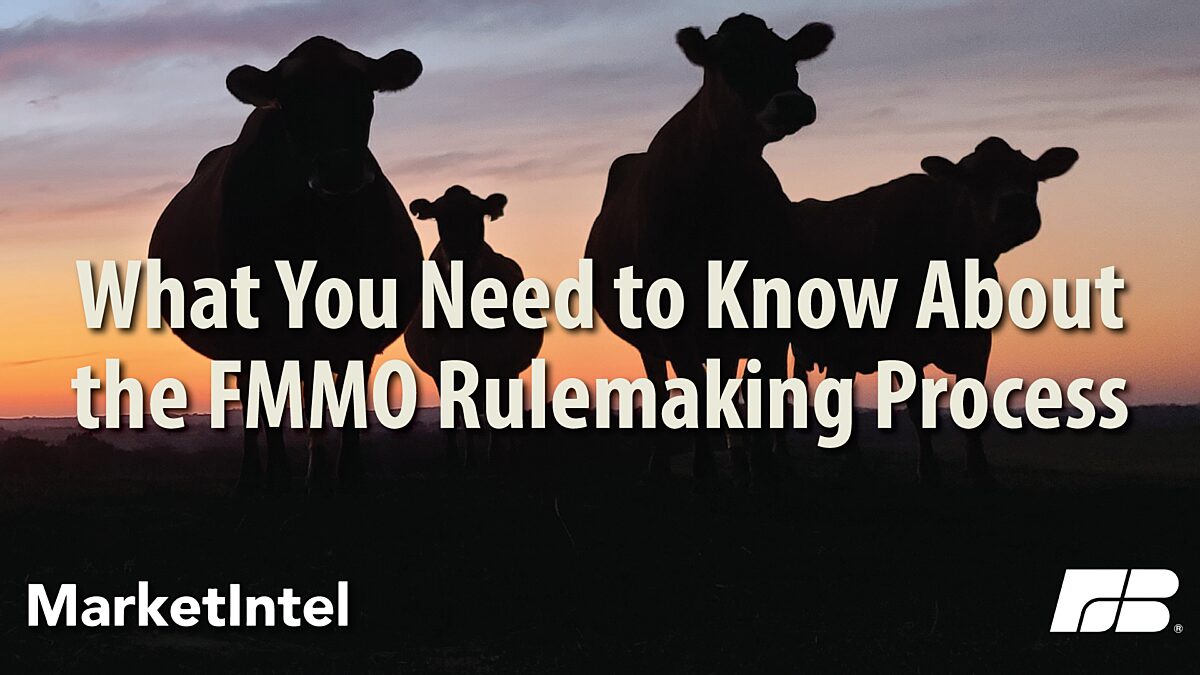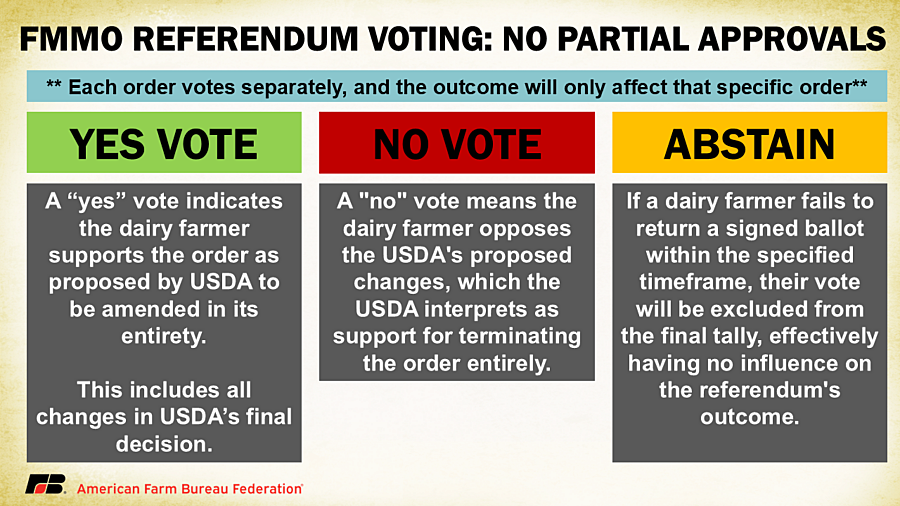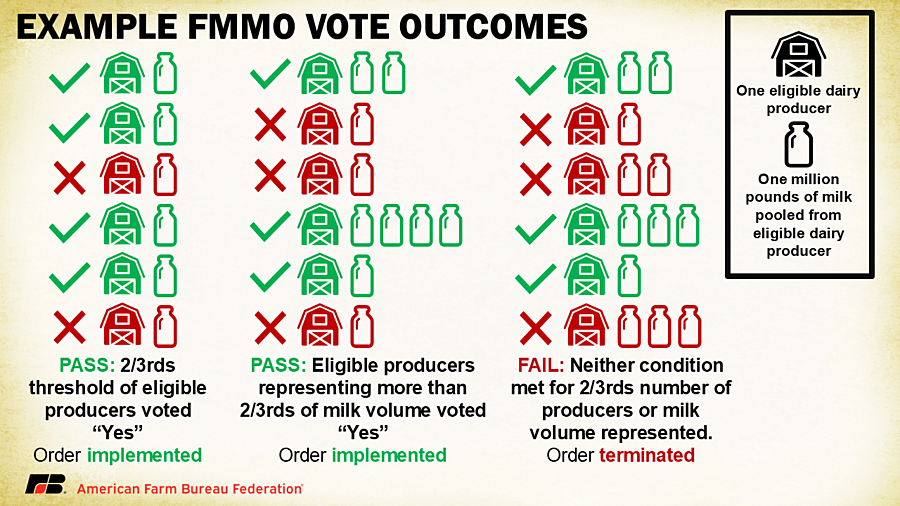Understanding the FMMO Referendum Process

Daniel Munch
Economist
Dairy farmers will soon have the opportunity to weigh in on proposed USDA Federal Milk Marketing Order amendments through a referendum process. While referendums are a routine part of FMMO proceedings, many dairy farmers may be unfamiliar with the specifics of how voting works, particularly given the complexities surrounding the FMMO system. The purpose of this article is to decode the referendum process, including what dairy farmers should expect, who is eligible and what a "yes" or "no" vote truly means for the future of their milk marketing order. The content of this article is based on information provided by USDA in their recent webinar: FMMO National Proceeding: Referendum Process.
How the FMMO Rulemaking Process Leads to a Referendum
The 12-step journey to a referendum begins with a formal hearing on stakeholder-proposed changes to the Federal Milk Marketing Order system. The most recent FMMO proceeding, which took place in Carmel, Indiana, from August 2023 to January 2024, represents the first comprehensive review of FMMO pricing formulas in over 20 years. Throughout the hearing, stakeholders, including the American Farm Bureau Federation, debated key issues such as make allowances, milk composition factors, and Class I differentials—factors that could significantly influence pricing formulas across the 11 existing federal orders. In July 2024, USDA's Agricultural Marketing Service issued a recommended decision, opening a comment period for feedback on proposed changes which closed September 13th, 2024. For an in depth review of the proposed amendments, please refer to Decoding USDA’s FMMO Recommendations – Extended Edition.
Only after the recommended decision comment period ends and the secretary of Agriculture makes a final decision does the referendum come into play. At this stage, dairy farmers pooled on an order have a say in whether the proposed amendments become the new rules of the game — or if the order itself is terminated. USDA must release a final decision by Nov. 12 (60 days from the comment deadline).
Voting on the Entire Order: No Partial Approvals
Dairy farmers should be aware that the referendum is an all-or-nothing proposition. A vote in favor means supporting the entire order as it is proposed to be amended. Conversely, a "no" vote supports terminating the order entirely, along with the timely payment requirements and third-party component verification benefits that come with it. Farmers cannot pick and choose specific amendments to keep or reject, nor can they vote to retain the status quo of the current order.
Each FMMO votes individually, meaning the outcome in one order only impacts that specific order. This could lead to some orders accepting the changes while others are terminated. USDA contends that terminating an order following a "no" vote is the correct interpretation of the Agricultural Marketing Agreement Act of 1937 (AMAA). However, some dairy stakeholders, including the American Farm Bureau Federation, argue that this interpretation is flawed and undermines the original intent of FMMOs to promote market stability.
Voter Eligibility and the Role of Cooperatives
Once a final decision is announced, USDA designates a "representative month" to determine which dairy farmers are eligible to vote. Essentially, all active dairy farmers who had milk pooled on an FMMO during this month are eligible. However, this process isn't as simple as filling out a ballot and mailing it back.
- Bloc Voting by Cooperatives: Cooperatives have a unique role in the referendum process. USDA-qualified cooperatives can choose to bloc vote on behalf of all their producer members pooled on the FMMO during the representative month. This means the cooperative submits a single vote that reflects the collective interests, and votes, of its members. However, cooperatives must decide to bloc vote for all members or allow all members to vote independently — there is no middle ground. The cooperative's vote is then counted either by the number of its eligible producers or the volume of milk those producers pooled, depending on how the approval criteria play out.
- Individual Producer Votes: For producers not part of a bloc-voting cooperative — or if their cooperative opts not to bloc vote — USDA will directly mail ballots to each eligible producer. For details on special cases, see the section below.
- The American Farm Bureau Federation’s Stance: The American Farm Bureau Federation supports a modified bloc voting system. This approach would require cooperatives to notify their members of the intended vote, allowing individual farmers to opt out and receive their own independent, confidential ballot. Under this framework, the cooperative could still bloc vote on behalf of those members who choose not to vote individually. However, there is currently no legislation that amends the AMAA to authorize this form of modified bloc voting. As it stands, dairy farmers who are members of cooperatives will not have the option to vote individually if their cooperative decides to bloc vote.
The Voting Process: Procedures and Best Practices
USDA designates a referendum agent — usually the market administrator — to handle the logistics of the voting process within each order. This agent determines eligibility, issues ballots, sets deadlines and ensures the integrity of the referendum. Here's what to expect:
- Ballot Distribution: Ballots are either sent to cooperatives for bloc voting or mailed directly to individual producers. The referendum agent uses records from readily available sources, including USDA records and producer records supplied by the milk handlers in the marketing area, to determine eligibility. Each ballot is accompanied by prepaid return envelopes, detailed information on the proposed order amendments, and a link to USDA's final decision. Producers and cooperatives must pay close attention to postmark and received-by deadlines, typically set within a 30–45-day window.
- Submission Requirements: To count, ballots must be signed and returned by the specified deadlines. Unsigned, late or ineligible ballots will be disqualified. Importantly, USDA does not provide confirmation of ballot receipt. Therefore, producers should consider obtaining a return receipt from the mail carrier to ensure their vote is counted. It’s also worth noting that ballots cannot be submitted via email or fax.
How USDA Determines the Outcome
Approval of the proposed amendments hinges on two key criteria, one of which must be met:
- Two-Thirds of Producers: At least two-thirds of the eligible producers voting in the referendum must vote "yes."
- Milk Volume: Producers representing more than two-thirds of the milk volume must vote in favor.
If either of these conditions is satisfied, USDA will issue a final rule implementing the amendments. If not, USDA will initiate steps to terminate the order. For cooperatives casting bloc votes, the vote count is based on either the number of eligible producers or the volume of milk those producers pooled, ensuring that the cooperative's collective interests are appropriately represented. The referendum outcome is determined solely by the dairy farmers and cooperatives who actively participate by casting a vote. Those who choose not to vote will not influence the final tally, meaning every submitted vote carries significant weight.
Special Scenarios: What Happens in Unique Voting Circumstances
- Multiple Farms: Producers owning multiple farms with the same ownership structure receive a single vote. However, if the ownership structures differ, each farm gets its own vote.
- Mixed Pooled Producers: If a producer had milk pooled both as a member of a bloc-voting cooperative and independently, the vote is assigned to the entity that pooled the greater volume of milk in the representative month.
- Dual Cooperative Members: If a dairy farmer is a member of multiple cooperatives and had milk pooled by more than one cooperative during the representative month, their vote would be assigned to the cooperative that pooled the greater volume of milk in the representative month.
- Producers on Multiple FMMOs: When amendments affect multiple FMMOs, separate referenda are conducted for each. Producers who pooled milk across multiple orders during the representative month will receive separate ballots for each order.
Result Implementation
After the referendum concludes, USDA will publish the results in the Federal Register. If the amendments are approved, USDA issues a final rule and announces the implementation details. If the referendum fails, the order will proceed toward termination. Importantly, USDA intends to maintain confidentiality throughout the process, keeping the number and manner of votes undisclosed.
Conclusion
As the referendum on USDA’s proposed amendments to the Federal Milk Marketing Orders approaches, it is vital for dairy farmers to understand the significance of their vote. While the American Farm Bureau Federation has raised concerns about certain aspects of the process — such as USDA’s interpretation that a "no" vote leads to the termination of an order, and the lack of flexibility for modified bloc voting — the focus now shifts to the dairy farmers themselves. This vote is an opportunity for dairy farmers to directly influence the rules that govern their market.
Given the potential for changes to minimum pricing formulas and regulations, participation in the referendum is crucial. Each farmer's vote will help shape how milk prices are determined and how products are valued moving forward. In a system with far-reaching impacts on farm operations and revenue, making your voice heard is more important than ever.
For more information on the referendum or to seek clarity on voting procedures, visit USDA's AMS hearing webpage or contact the FMMO inbox at FMMOHearing@usda.gov .
Top Issues
VIEW ALL

